Polycrystalline chalcogenide ceramic material
a technology of polycrystalline chalcogenide and ceramic materials, which is applied in the field of polycrystalline materials, can solve the problems of reducing the ability of the window or dome to transmit infrared light, reducing the strength of the window material, and reducing the degree of transparency. , to achieve the effect of preventing rapid grain growth, reducing residual porosity, and high transparency
- Summary
- Abstract
- Description
- Claims
- Application Information
AI Technical Summary
Benefits of technology
Problems solved by technology
Method used
Image
Examples
examples 1-6
were using a die with a radius of 25 cm, whereas Examples 7-8 were using a die with a radius of 127 cm.
TABLE 2Properties of ZnS Ceramic CompositionsAccording to the InventionExtinction CoefficientGrainat 1100 nmKnoop HardnessSizeExample(cm−1)(kg / mm2)(μm)12.11902.0921.81963.7332.02124.3241.82303.1552.42273.1962.32164.1870.225780.5250ZnS0.05-0.2150-16520-100MultiSpectral ®CLEARTRAN ®0.05-0.214720-100ZnS FLIR 3.60210-2402-8 material1
ZnS MultiSpectral® is a ZnS material from II-VI Infrared which is made by chemical vapor deposition and is modified by a hot isostatic press (HIP) process. The material exhibits transmission in the 0.4 to 12 micron range.
CLEARTRAN® is a ZnS material from DOW which is made by chemical vapor deposition and is modified by a hot isostatic process. The material exhibits transmission in the 0.35-14 μm range.
1ZnS from II-VI Infrared produced by chemical vapor deposition (CVD). The material is used in the 8 to 12 micron region.
[0053]FIG. 3 is a table showing the Vi...
PUM
| Property | Measurement | Unit |
|---|---|---|
| extinction coefficient | aaaaa | aaaaa |
| extinction coefficient | aaaaa | aaaaa |
| extinction coefficient | aaaaa | aaaaa |
Abstract
Description
Claims
Application Information
 Login to View More
Login to View More - R&D
- Intellectual Property
- Life Sciences
- Materials
- Tech Scout
- Unparalleled Data Quality
- Higher Quality Content
- 60% Fewer Hallucinations
Browse by: Latest US Patents, China's latest patents, Technical Efficacy Thesaurus, Application Domain, Technology Topic, Popular Technical Reports.
© 2025 PatSnap. All rights reserved.Legal|Privacy policy|Modern Slavery Act Transparency Statement|Sitemap|About US| Contact US: help@patsnap.com



